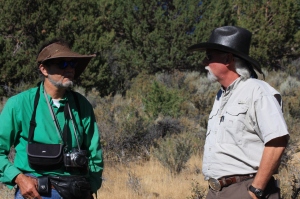Craig Downer and R.T. Fitch at Twin Peaks Roundup ~ photo by Terry Fitch
From: Craig Downer
To: bbbmavemedwhg@blm.gov
Cc: Craig Downer
Sent: Sun, January 30, 2011 4:59:49 PM
Subject: Re: Triple B, Maverick-Medicine and Antelope Valley HMA’s Preliminary E.A. DOI-BLM-NV-L010-2011-0004-EA
January 30, 2011
BLM Ely District Office
HC 33 Box 33500
Ely, NV 89301
Attn: Gary W. Medlyn, Egan Field Manager
Email: bbbmavemedwhg@blm.gov
Re: Triple B, Maverick-Medicine and Antelope Valley HMA’s Preliminary Environmental Assessment DOI-BLM-NV-L010-2011-0004-EA
Dear Sirs:
Thank you for this opportunity to give input. I have reviewed the E.A. and am disturbed by the repeated arguments that I have read many times before as concerns “wild horse overpopulation,” “multiple use,” “thriving ecological balance,” etc. The employment of these terms to justify what you are planning to do to the wild horses makes a mockery of their true meaning.
Objectively there is no overpopulation of wild horses in the herd management areas/wild horse territories under consideration. How can there be when the current estimated population of 2,198 wild horses translates into 766 acres per individual wild horse in 1,682,998 acres of hma’s (BLM) or wild horse territories (USFS)? After the proposed roundup to reduce the population by 1,726 to 472 wild horses, there would remain an immense 3,566 acres of legal habitat per individual wild horse. This would be a nearly wild-horse-empty wild horse hma complex. This mocks the Wild Free Roaming Horse and Burro Act (WFRHBA) where it clearly states that wild horse/burro herd areas shall be dedicated “principally though not necessarily exclusively” to the wild horses/burros in the wild. This latter is in keeping with the multiple use concept of the public lands (upheld by the Federal Land Policy and Management Act as well as the Multiple Use Act), since the wild horse and burro areas only represent a small percentage of the public lands (ca. 12%). To squeeze their population down to such radically low levels expands the monopoly of livestock upon the public lands as a whole. I detect a biased motivation operating to the detriment of the wild horses and burros. Year after year, this further displaces the wild equids and reduces their numbers, ignores their legal right to freedom and land, further disrupts their natural adaptation where found as well as their self-stabilizing societies, etc.
Examining Tables 3, 4 & 5 of your EA, I see that there are a total of 28 livestock grazing permittees/allotments of which 17 have 90% to 100% of their allotments within the hma’s. These livestock graziers have a total of currently permitted livestock Animal Unit Months (AUM’s) of 88,978 on a year round basis. Since the current wild horse population is 2,198, there are 26,376 AUM’s (2,198 x 12 months) currently being utilized by wild horses in the complex. This represents a little less than 30% of livestock AUM’s and only 23% of the total livestock plus wild horse AUM’s of 115,354. This is not an overwhelming percentage and in no fashion constitutes the “principal” in these hma’s. Yet, unsatisfied with this, your plan is to reduce the herds to the lower end Appropriate Management Level (AML) of 472 wild horses. This figure of 472 represents 5,664 AUM’s per year, which is only 6.4% of permitted livestock AUM’s and a little under 6% of combined livestock and wild horse year-round AUM’s. The upper end of the AML is 889, which multiplied by 12 months equals 10,668 AUM’s per year. This is still only about one-nineth of livestock within the wild horse complex …even less of the combined.
This is an extreme marginalizing of the wild horse presence and, for this reason, I urge you to increase the AUM’s for wild horses, and to decrease the AUM’s for livestock, with the goal being that wild horses receive at least 50% of the grazing allotments in order to comply with the “principal” mandate of WFRHBA. I therefore favor the No Action alternative proposal in your EA and urge you to reformulate a more just plan here, employing principles of Reserve Design that involve buffer zones, natural barriers and predators, and the allowing of the wild horses to fill their niche and naturally self-stabilize. This would obviate the cruel and biologically disruptive helicopter roundups that are now causing such enormous problems, suffering and death for the wild horses.
Finally, I urge you to hold your ground in the water issue in Nevada and not be cajoled by vested interests — under the guise of state’s rights — into relinquishing water for the wild horses. As a 4th generation Nevadan and holder of my high school’s history award, I know that the Nevada State Constitution gives top priority to the federal government on all lands that were not claimed during the first several years after the Civil War and the formation of Nevada.
Please feel free to contact me for further details about my protest of your proposal, reserve design, etc. Again I appreciate this opportunity to give input and look forward to hearing from you again soon.
Sincerely,
Craig C. Downer, Wildlife Ecologist










No comments:
Post a Comment